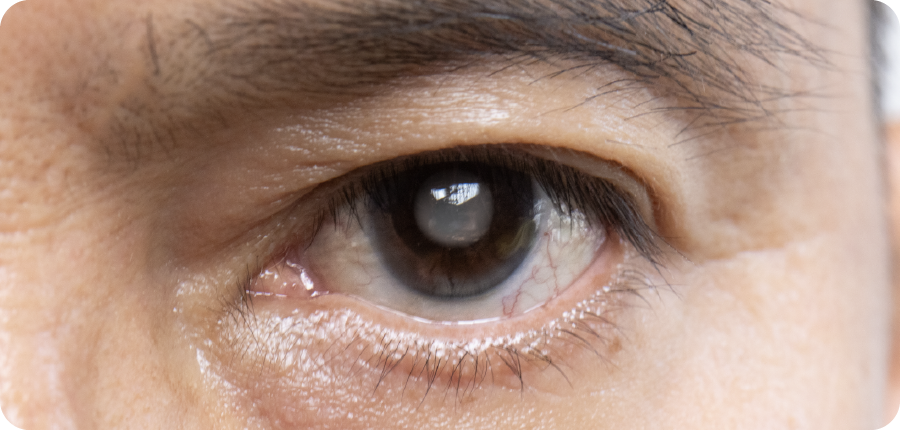
Have you noticed cloudy or blurry vision? It could be a sign of cataracts.
This is among the first responses when people ask, “What is the first sign of cataracts?”. Cloudy vision or blurry vision is a common symptom of this eye condition.
Cataracts are a serious eye condition and have long been among the leading causes of vision loss. Older adults are generally at the most risk, but younger people may also develop them.
This article outlines all you need to know about cataracts – from eye cataract symptoms, causes, and how they affect vision.

Cataracts occur when the normally clear lens in your eye turns cloudy.
Light has to pass through this lens in order to reach your retina, or the light-sensitive membrane at the back of the eye. Light reaching the retina leads to the images that compose our vision.
Clouding in the lens interferes with the light that is supposed to enter the eye. This is why people with cataracts notice their vision becoming blurrier or dimmer.
Most cataracts develop gradually and are age-related. As we age, the proteins in the eye start to deteriorate and clump together – these clumps create the cloudiness that forms a cataract.
Over time, more and more clumps form, causing the cloudiness to become worse.
This also explains the gradual decline in vision that people with cataracts experience. As the cataract progresses, less light enters the eye to help our retinas and brain form images.
Because most cataracts develop slowly, they are rarely noticeable at first. It can take time before someone notices them interfering with daily activities or tasks.
These are some signs and symptoms of cataract development:

The most common cataract symptom, as mentioned earlier, is cloudy vision.
Most patients notice this when reading or watching TV. If they wear eyeglasses, the blurriness will be present even if they get updated ones.
If you find your vision seeming to get dimmer, this may be a sign of a cataract.
People with cataracts often find that well-lit environments still look dim to them. Some also take to switching on lights in their environments earlier in the day compared to before.

Cataracts may also lead to glare, starbursts or haloes around lights. This may be particularly noticeable in dim environments.
Most people notice these symptoms during nighttime. Some also note increased difficulty with driving at night due to worsening glare from other cars’ headlights.
If colours are starting to fade or look dull, a cataract could be the culprit. Another possible symptom is the increasing yellowing in one’s vision.
For instance, whites may no longer look appropriately white. Alternatively, objects known to be highly saturated could start to look dull or washed out.
This is also called monocular diplopia. Cataracts can cause this to happen in the affected eye.
Certain medical conditions as well as habits can accelerate cataract development. Specific lifestyle choices can also increase the risk of developing them.

High blood sugar can alter the lens of the eye, leading it to swell and age more quickly. This is why high sugar intake can be a risk factor too.
In line with this, people with diabetes have been found to be at increased risk for cataracts. The National Eye Institute estimates the risk to be 2 to 5 times higher for diabetics.
UV or ultraviolet rays can also damage the body’s cells. This is why prolonged exposure to UV rays can lead to the proteins in the lens deteriorating enough to clump.
In sunny climates like Singapore’s, this is a genuine concern. Therefore, people are advised to wear sunglasses when out and about in the daytime.

A direct injury to the eye, either blunt or sharp trauma, can lead to disruption in the natural lens fibres and accelerated cataract formation.
Smoking is an activity that can increase oxidative stress. This translates to quicker breakdown of the proteins in the lens, which leads to a higher risk of cataract formation.

Cataracts are treatable with surgery. This is generally recommended as a step when the cataract has begun to interfere with the patient’s everyday life.
Modern cataract surgery is generally safe and has a high success rate. Patients no longer have to wait for the cataract to be "ripe" for surgery.
The operation for cataract treatment is typically performed under local anaesthesia. First, a small incision is made in the cornea, the front part of the eye.
The cataract is first broken up either manually with instruments or with a laser and then emulsified with ultrasound. This means that the solid lens becomes liquefied. After that, it’s removed. It’s often suctioned out through the corneal incision.
A replacement lens is then inserted into that area. This is called an IOL or artificial intraocular lens. It does the work that the formerly clear lens performed: focusing light properly onto the retina.
If left untreated, a cataract can cause a patient’s vision to continue deteriorating. This is because the blurry patch obstructing light from entering the eyes gets worse.
Daily tasks such as reading or recognising faces may become harder over time. This type of vision impairment can lead to other problems, including falls or accidents.
In the most severe cases, cataracts can even lead to other complications like glaucoma.
Since cataracts are progressive, they should be treated before they lead to serious vision loss or impairment. Early diagnosis and surgical intervention can help patients preserve their quality of life.
Regular eye checks can help you determine if you have this condition. If you already suspect you have it, book an eye screening with our specialists for confirmation or diagnosis.